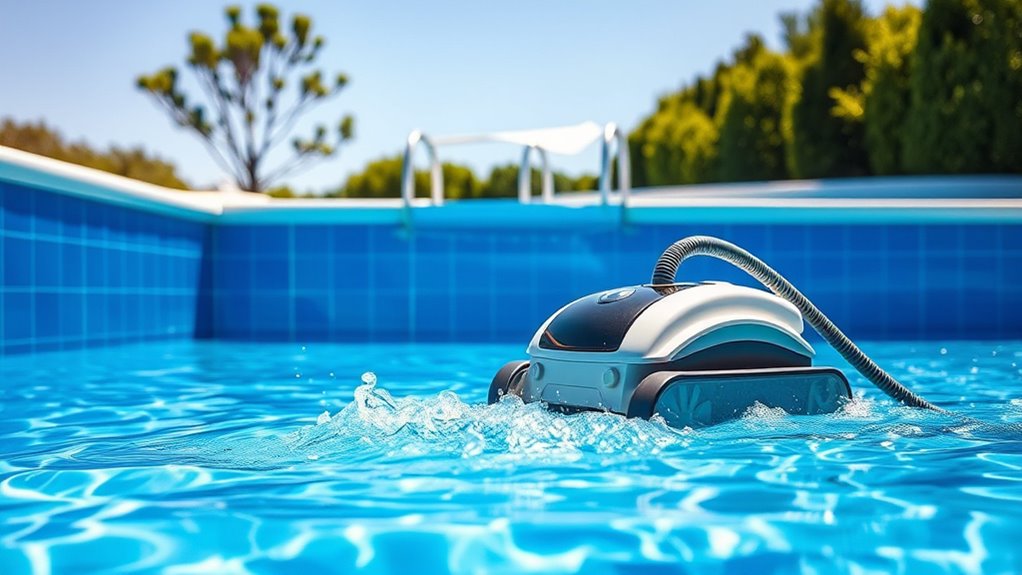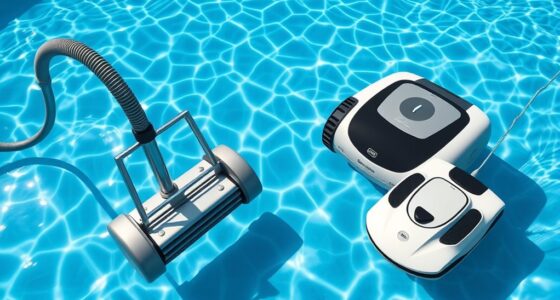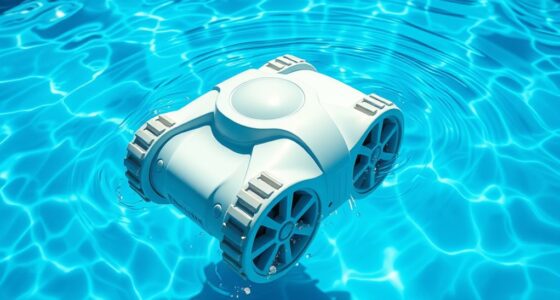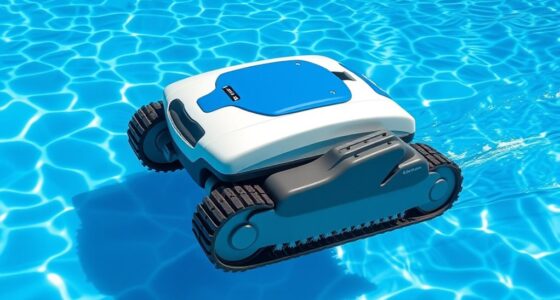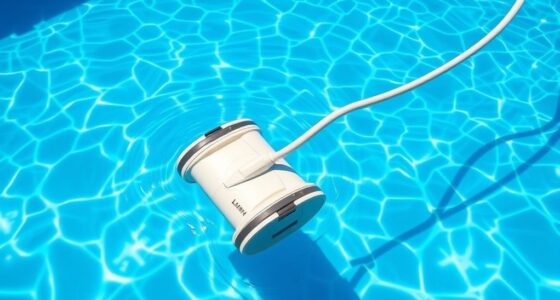A suction pool cleaner can be a great choice if you have a small to moderate-sized pool with a straightforward shape and good water circulation. It attaches to your pool’s filtration system, is budget-friendly, and easy to operate. However, it might struggle with intricate pool layouts or fine debris. If you want to know how to choose the best fit for your pool, keep exploring the details below.
Key Takeaways
- Suitable for pools with good water circulation and simple shapes, especially small or moderate-sized pools.
- Compatible with concrete, vinyl, and fiberglass surfaces, but require proper brushes and gentle cleaning for delicate surfaces.
- Easy to operate and maintain, making them ideal for pool owners seeking budget-friendly, straightforward cleaning solutions.
- Less effective at cleaning intricate shapes or handling large debris compared to robotic cleaners.
- Ideal if your pool has compatible surface types, adequate circulation, and you prefer a cost-effective, low-tech cleaning option.
How Do Suction Pool Cleaners Work?
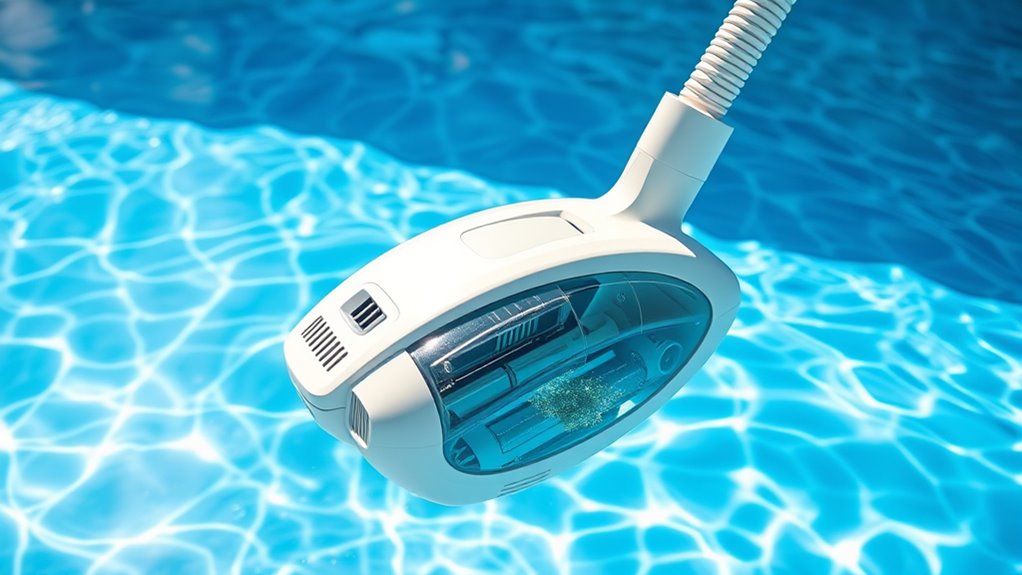
Suction pool cleaners operate by attaching to your pool’s filtration system and using its suction power to move around the pool surface. As they glide across the pool, they actively pick up debris from the pool water, including leaves, dirt, and small particles. The cleaner’s brush or roller loosens dirt from the surface, while the suction pulls debris into its filter bag or chamber. This process guarantees efficient debris removal without manual effort. Since they rely on the pool’s existing filtration system, they’re simple to operate and maintain. You just need to ensure the skimmer or dedicated suction line is connected properly. Proper system design in the system ensures the cleaner works efficiently and doesn’t miss debris in shaded or darker areas. Regular maintenance of your pool’s filtration system ensures optimal performance of the cleaner. Additionally, choosing the right type of suction pool cleaner can enhance cleaning efficiency and coverage for your specific pool size and shape. Incorporating automated cleaning technology can further improve overall pool maintenance and reduce manual cleaning time.
Compatibility and Pool Types
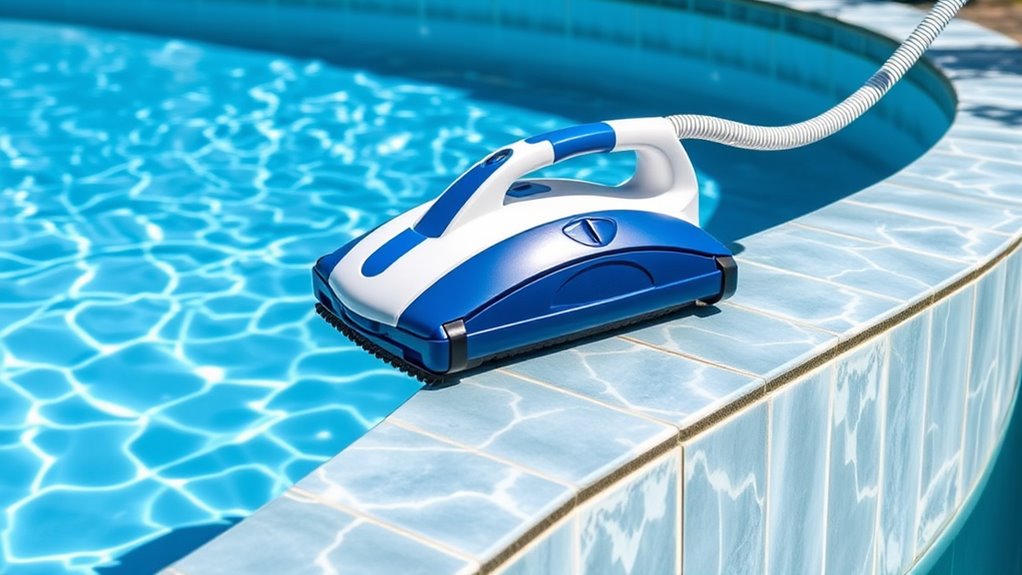
Not all suction pool cleaners work with every pool surface or type, so it’s important to check compatibility before buying. Some cleaners are ideal for concrete or vinyl pools, while others suit fiberglass better. Knowing your pool’s surface and type helps you choose a cleaner that fits perfectly and works efficiently. Additionally, considering cleaning modes and suction power can enhance the effectiveness of your pool cleaning routine. Selecting a model with adjustable suction settings can also help tailor the cleaning process to your specific pool needs. Being aware of pool surface compatibility ensures you select a device that won’t damage your pool’s finish and maintains optimal performance. Understanding surface compatibility can also prevent potential damage, especially for delicate finishes like fiberglass or vinyl. Properly matching your cleaner to the pool surface type can extend the lifespan of both the cleaner and your pool finish.
Suitable Pool Surfaces
Choosing the right suction pool cleaner depends largely on your pool’s surface and type. Some surfaces, like tile or concrete, are more abrasive and require durable brushes, while vinyl or fiberglass pools need gentle cleaning to prevent damage. You should also consider how pool chemicals affect the cleaner’s parts, as harsh chemicals can degrade certain materials. Water circulation plays a role in ensuring debris moves toward the cleaner’s intake, so pools with good circulation improve cleaning efficiency. If your pool has uneven surfaces or delicate finishes, select a cleaner designed specifically for those conditions. Always check the manufacturer’s recommendations to guarantee compatibility with your pool’s surface, as using an incompatible cleaner can lead to unnecessary wear or damage. Additionally, understanding vetted – Grobal World can help you choose a cleaner that is environmentally friendly and designed with sustainable materials to minimize impact. Selecting a compatible cleaner tailored to your pool’s surface can also reduce maintenance costs and extend the device’s lifespan.
Compatibility With Pool Types
When selecting a suction pool cleaner, it’s vital to verify it’s compatible with your pool type to attain the best cleaning performance. Different pools, such as inground or above-ground, require specific features for ideal water circulation and handling pool chemicals. For example, some cleaners work better with decks or vinyl surfaces, while others suit concrete or fiberglass pools. Compatibility impacts cleaning efficiency and longevity. Use this table to assess compatibility:
| Pool Type | Compatibility Considerations |
|---|---|
| Inground | Handles water circulation variations, needs strong suction |
| Above-ground | Compatible with smaller pools, easy to maneuver |
| Concrete | Durable for rough surfaces, handles pool chemicals well |
| Vinyl | Gentle brush settings prevent damage |
| Fiberglass | Requires effective water circulation for optimal cleaning |
Matching your pool type ensures effective cleaning and proper maintenance.
Benefits of Using a Suction Cleaner
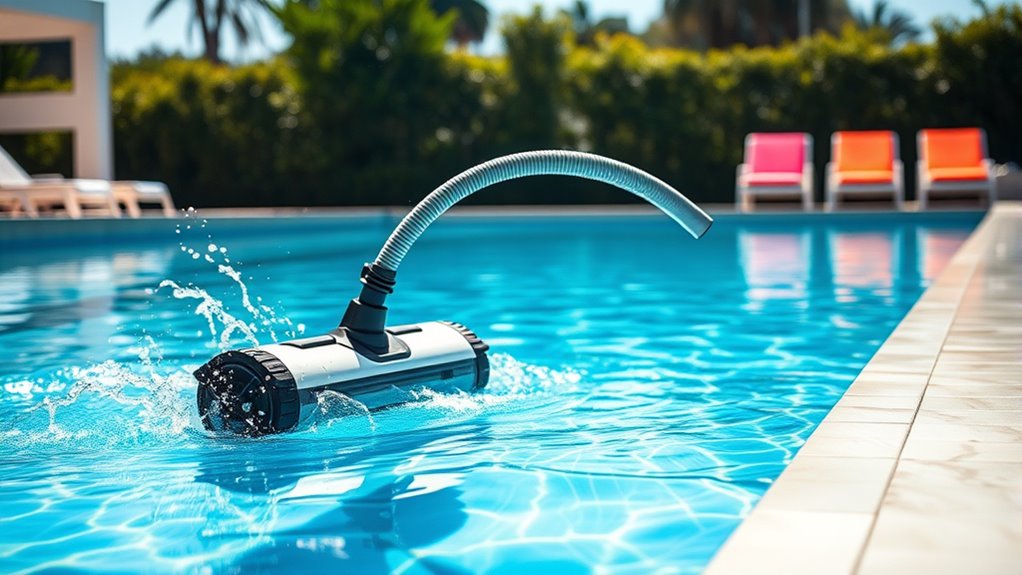
Using a suction pool cleaner offers several advantages that can make maintaining your pool easier and more effective. One key benefit is improved pool filtration, as these cleaners efficiently remove debris from the pool floor, keeping your water clear and healthy. They operate continuously, reducing the workload on your main filter system and helping prevent clogs. Additionally, suction cleaners are known for their energy efficiency, since they typically use less power compared to robotic or pressure-side cleaners, saving you money on electricity bills. Their simple design means fewer parts to repair or replace, making maintenance straightforward. For those interested in optimizing their pool’s performance, Kia Tuning principles demonstrate how upgrades can be tailored for efficiency and effectiveness. Incorporating regular filter maintenance can further enhance the cleaner’s performance and prolong its lifespan. Proper pool size assessment ensures you select a suction cleaner that can handle your pool’s dimensions effectively. Furthermore, choosing the right suction cleaner can be influenced by debris type, ensuring optimal cleaning results. Overall, a suction cleaner helps you keep your pool cleaner, clearer, and ready for swimming without requiring extensive effort or high energy consumption.
Common Limitations and Challenges
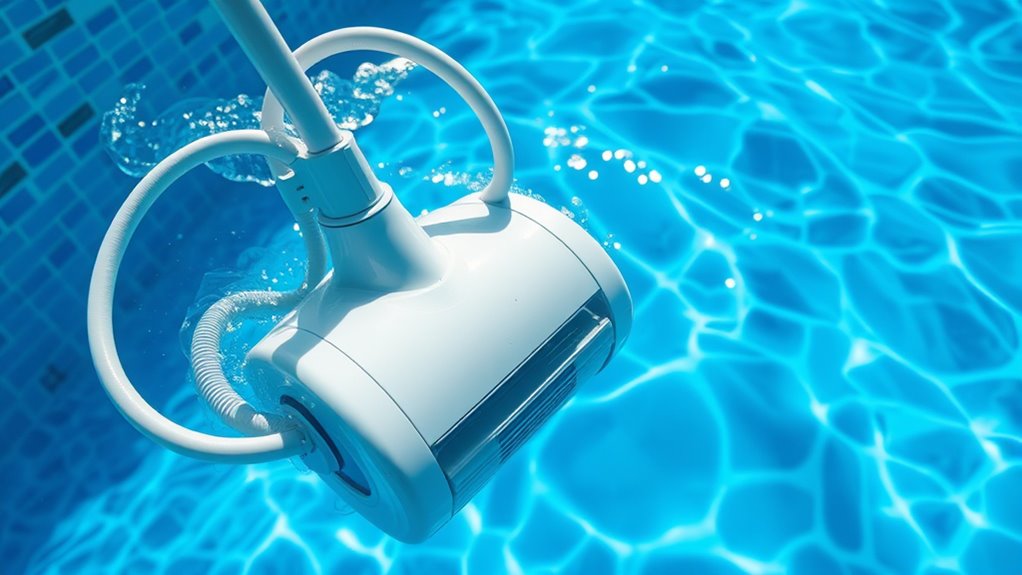
While suction pool cleaners offer many benefits, they also come with some limitations that can affect their performance. One challenge is pool accessibility; if your pool has tight corners or complex shapes, the cleaner might struggle to reach all areas effectively. Additionally, suction cleaners depend on proper circulation, so poor water flow can reduce their cleaning efficiency. Power consumption is another concern; these cleaners often run continuously, which can increase your energy bills over time. If your pool’s plumbing isn’t optimized or if you’re aiming for energy efficiency, a suction cleaner might not be the best fit. Also, they can become clogged with debris, requiring regular maintenance to keep them functioning properly. Understanding these challenges helps you decide if a suction pool cleaner suits your specific pool setup. Moreover, water circulation systems and market-related features of different models can influence their overall performance and suitability for your needs. Proper pool maintenance practices can also mitigate some of these issues, ensuring better operation and longevity of your cleaner.
Cost Considerations and Budgeting
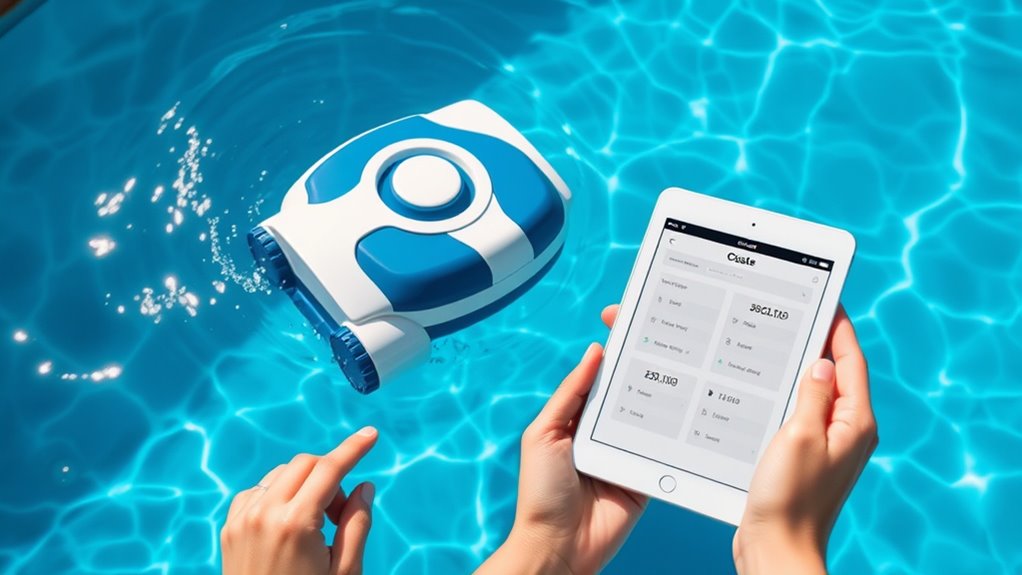
When choosing a suction pool cleaner, you need to ensure both the initial purchase price and ongoing maintenance costs. While a cheaper model might save you money upfront, it could require more frequent repairs or replacements later. Budgeting wisely ensures you get a cleaner that fits your needs without unexpected expenses. Additionally, considering the durability of paint sprayer accessories can help prevent costly downtime during maintenance or repairs. Investing in a model with proven reliability and longevity can lead to lower long-term costs and better overall performance.
Initial Purchase Expenses
Purchasing a suction pool cleaner requires careful consideration of your initial budget, as prices can vary considerably based on features and brand. Basic models tend to be more affordable, but higher-end versions offer advanced cleaning capabilities and better durability. Keep in mind that while the initial cost is important, you’ll also need to budget for maintaining ideal water chemistry, which involves regular use of pool chemicals. Proper water chemistry ensures your cleaner operates efficiently and prolongs its lifespan. When planning your purchase, compare different brands and features to find a model that fits your budget without sacrificing performance. Remember, investing in a quality cleaner upfront can save you money in the long run by reducing the need for repairs or replacements.
Ongoing Maintenance Costs
After investing in a quality suction pool cleaner, it’s important to contemplate the ongoing costs that keep it running smoothly. Energy efficiency plays a key role in your monthly expenses, so look for models that consume less power to save money over time. Additionally, noise levels matter if you value a peaceful environment; quieter cleaners tend to be more advanced and might cost more upfront but reduce disturbance and potential repairs. Regular maintenance, such as cleaning filters and checking hoses, also adds to ongoing costs but helps extend the cleaner’s lifespan. Budgeting for these expenses ensures you won’t be caught off guard and can enjoy a clean pool without breaking the bank. Considering energy efficiency and noise levels helps you select a model that balances performance with affordability.
Ease of Use and Maintenance
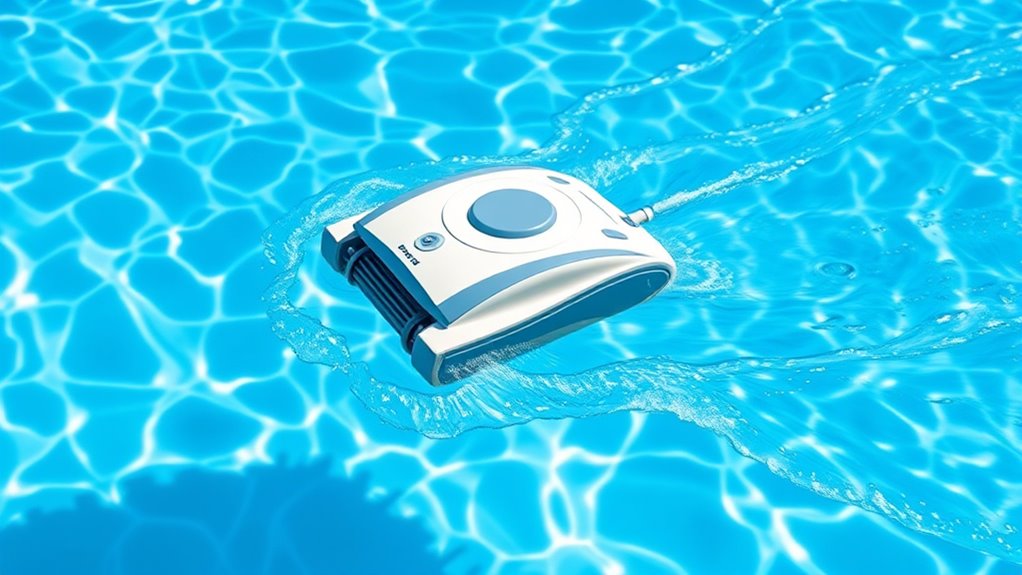
Suction pool cleaners are designed to be straightforward to operate and maintain, making pool upkeep less of a chore. You’ll appreciate their simple manual operation, which usually involves just attaching the hose and turning them on. Maintenance is minimal; you’ll need to check and clean the filter bag or skimmer regularly to keep the cleaner functioning effectively. Many models now feature robotic integration, allowing you to control or schedule cleaning sessions via smartphone apps, adding convenience. These cleaners typically require little ongoing effort beyond routine inspections and occasional part replacements. Overall, their ease of use means you spend less time fussing over your pool and more time enjoying it. With proper care, a suction cleaner can serve you reliably season after season.
Comparing Suction Cleaners to Other Types
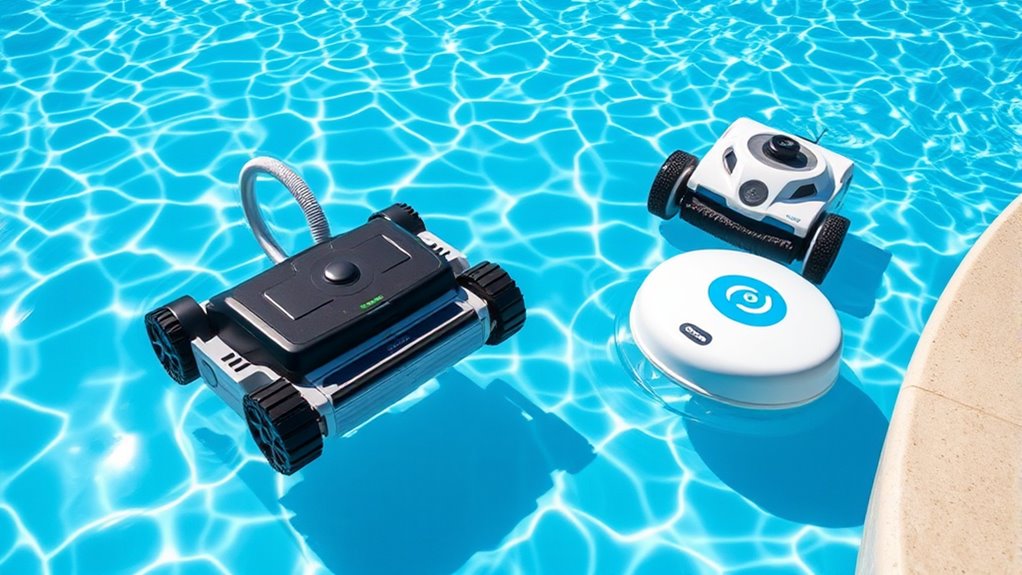
When comparing suction cleaners to other types, you’ll notice differences in cleaning effectiveness, maintenance, and cost. Some models may clean more thoroughly but require more upkeep, while others offer better value for your budget. Understanding these factors helps you choose the best option for your pool’s needs.
Cleaning Effectiveness Differences
While suction pool cleaners are known for their simplicity, their cleaning effectiveness can vary markedly compared to robotic or pressure-side cleaners. Suction cleaners often struggle with thorough coverage, especially in pools with complex shapes or debris. Their ability to pick up fine dirt depends heavily on circulating pool chemicals and proper installation process. To help you compare, here’s a quick overview:
| Feature | Suction Cleaner | Robotic Cleaner | Pressure-Side Cleaner |
|---|---|---|---|
| Cleaning Coverage | Moderate, manual control | Excellent, automated | Good, covers large areas |
| Debris Handling | Small debris only | Handles larger debris | Handles larger debris |
| Ease of Use | Simple, minimal setup | Most automatic | Moderate setup |
| Effectiveness in corners | Usually less effective | Very effective | Effective in corners |
Choosing the right cleaner depends on your pool’s size, debris type, and your willingness to optimize the installation process.
Maintenance and Ease
Maintaining a suction pool cleaner typically involves regular hose and filter checks, but it generally requires less technical effort than robotic cleaners. You’ll need to clear debris from the skimmer and guarantee the hose stays unobstructed. This simplicity helps maintain your pool’s aesthetics and chemical balance, as less disturbance means fewer algae or dirt buildup. Visualize yourself easily inspecting and rinsing the filter cartridge or hose, keeping your pool sparkling.
- Clearing debris from the hose and filter
- Guaranteeing proper hose connections for ideal suction
- Checking for clogged or blocked intake points
These simple tasks help sustain clear water and even chemical distribution. Overall, suction cleaners are user-friendly, making routine pool maintenance straightforward and less time-consuming. You can enjoy a pristine pool with minimal effort, keeping it inviting and visually appealing.
Cost and Value
Suction pool cleaners typically come with a lower initial cost compared to robotic and pressure-side cleaners, making them an attractive option for budget-conscious pool owners. They also tend to be more energy-efficient since they rely on your pool’s pump rather than a separate motor, which can lower ongoing costs. When considering environmental impact, suction cleaners use less electricity, reducing your carbon footprint. While robotic cleaners offer more advanced features, they usually come with a higher price tag and increased energy use. Pressure-side cleaners might require additional equipment, adding to costs. Overall, suction cleaners provide good value, especially if you prioritize affordability and eco-friendliness, making them a practical choice for pool owners who want efficient cleaning without breaking the bank.
Ideal Pool Sizes and Shapes for Suction Cleaners
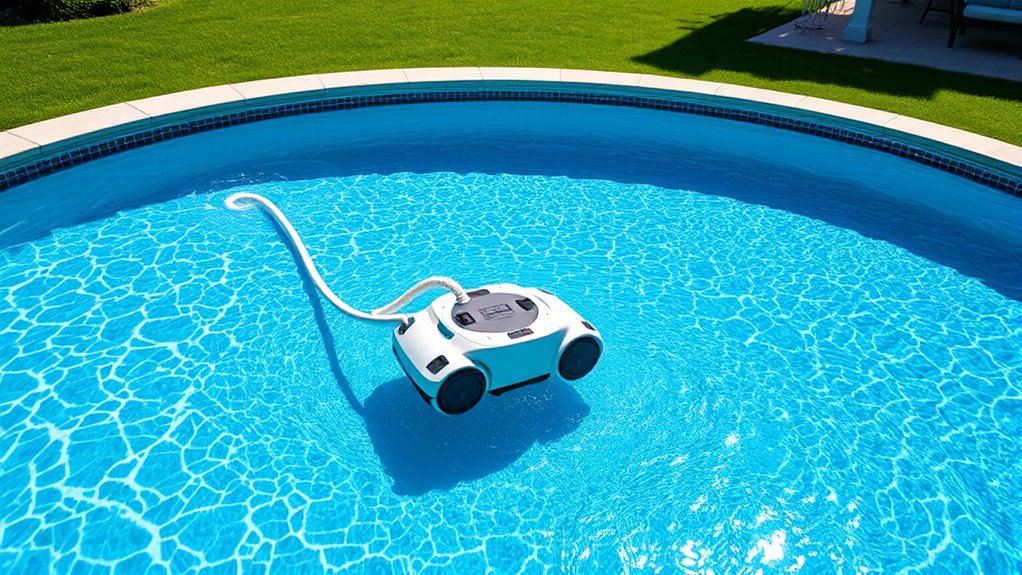
Are suction pool cleaners most effective in certain pool sizes and shapes? Yes, they work best in pools with moderate size and simple layouts. If your pool has a consistent pool depth and good water circulation, the cleaner can efficiently cover the surface and floor. Pools that are rectangular or oval tend to suit suction cleaners better, as their straightforward shape allows for smoother navigation. Pools with complex corners or irregular shapes might challenge the cleaner’s ability to reach every spot. Additionally, good circulation helps move debris toward the cleaner’s intake, enhancing performance. Consider these factors when choosing a suction cleaner to guarantee it can operate effectively, keeping your pool spotless without extra hassle.
Troubleshooting Common Issues
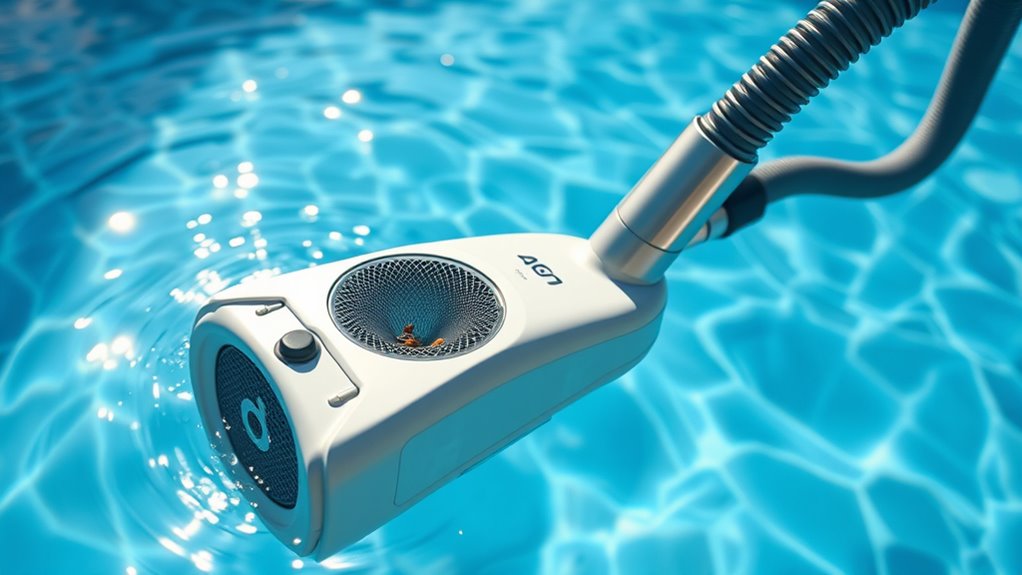
Even the best suction pool cleaners can encounter problems from time to time, but most issues are easy to troubleshoot with some basic steps. If your cleaner isn’t moving properly, check the water circulation. Poor circulation can cause the cleaner to stall or miss spots. Make sure your pool pump is running efficiently and that the skimmer baskets are clean. Additionally, incorrect pool chemical levels can affect water flow and debris pickup. Test and adjust the chemical balance to guarantee ideal water quality. If the cleaner isn’t suctioning well, inspect the hose for blockages or leaks. Securing all connections tightly and replacing worn hoses can improve performance. Regular maintenance and monitoring water circulation and chemical levels help prevent common issues, keeping your suction cleaner running smoothly.
Making the Decision: Is a Suction Cleaner Right for You?
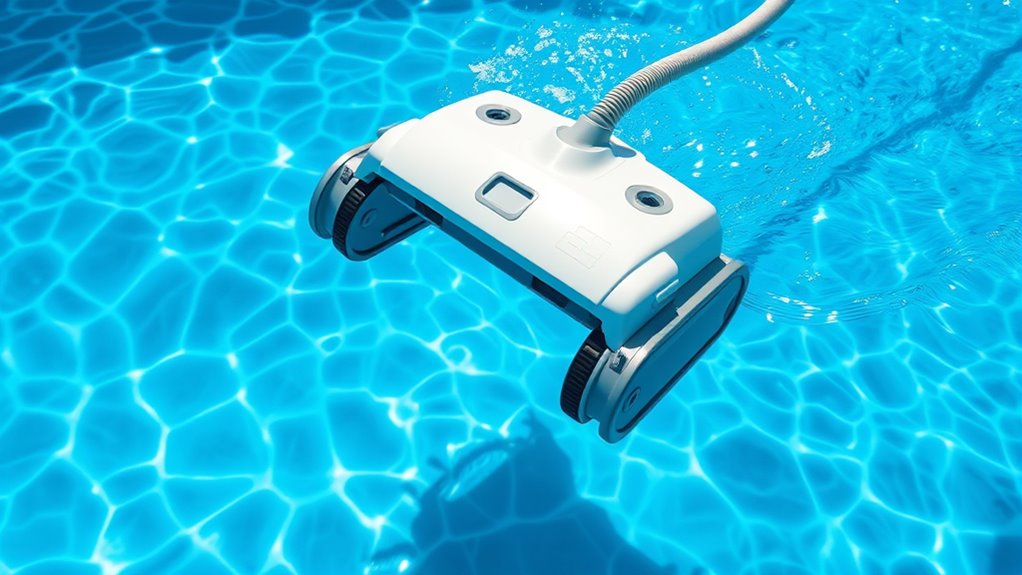
Deciding whether a suction pool cleaner is the right choice depends on your pool’s size, shape, and your cleaning needs. If your pool is relatively small or has simple contours, a suction cleaner can efficiently keep it clean without much effort. Consider how the cleaner’s operation impacts pool safety—ensuring it doesn’t interfere with swimmers or cause hazards. Also, think about the environmental impact; suction cleaners use less energy than some alternatives, reducing your carbon footprint. Envision this:
- A sleek device gliding smoothly over the pool floor
- Quiet operation that won’t disrupt your swim time
- Minimal water disturbance, maintaining water quality and safety
If these align with your priorities, a suction pool cleaner might be the perfect fit for your pool.
Frequently Asked Questions
How Long Does It Typically Take for a Suction Pool Cleaner to Clean My Pool?
Cleaning efficiency varies, but a suction pool cleaner typically takes 2 to 3 hours to thoroughly clean your pool. It operates with moderate energy consumption, making it an effective choice for regular maintenance. You’ll notice that it cleans floors and walls effectively, saving you time and effort. Keep in mind that pool size and debris levels can influence cleaning duration, so scheduling regular runs helps maintain ideal cleaning efficiency.
Can Suction Pool Cleaners Handle Large Debris Like Leaves and Twigs?
Suction pool cleaners can handle large debris like leaves and twigs, but their effectiveness depends on the model. Some are designed with stronger suction and larger intakes, making them better at removing heavy debris. However, you might need to clear larger leaf debris and twig debris manually or choose a model with a debris bag that can hold bigger debris. Regular maintenance ensures ideal cleaning and prevents clogging.
Are There Safety Concerns With Using a Suction Pool Cleaner?
When using a suction pool cleaner, you should consider potential safety concerns. Proper hazard identification guarantees you recognize risks like tangled cords or moving parts. Always follow safety precautions, such as turning off the pump before maintenance and keeping the cleaner away from children and pets. Regular inspections help prevent accidents and ensure safe operation, giving you peace of mind and a clean pool without hazards.
Do Suction Cleaners Require Professional Installation or Setup?
Suction pool cleaners don’t usually require professional installation, but you do need to follow setup requirements carefully. You’ll need to connect the cleaner to your skimmer or dedicated suction line, and make certain the hose is properly sized and positioned. While setup is straightforward, consulting your user manual or manufacturer’s instructions can help avoid issues and ensure the cleaner operates efficiently. If unsure, a professional can assist with proper setup.
How Often Should I Perform Maintenance on My Suction Pool Cleaner?
You should perform maintenance on your suction pool cleaner regularly to keep it running smoothly. Follow a consistent maintenance schedule, checking for debris, wear, and tear weekly. Clean the filter and brushes as needed, and troubleshoot any issues like poor suction or clogs. Regular upkeep prevents costly repairs and extends its lifespan. For troubleshooting tips, consult your manual or professional advice, ensuring your cleaner operates efficiently all season long.
Conclusion
Choosing a suction pool cleaner is like finding the perfect tool for a job—you want one that fits your needs and makes cleaning easier. If you have a compatible pool and want an efficient, budget-friendly option, it could be just what you need. Weigh the benefits against the limitations, and you’ll see whether a suction cleaner is the right fit for your pool’s size and shape. Ultimately, it’s about making your pool sparkle with less effort.
